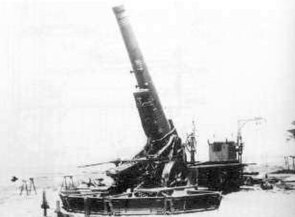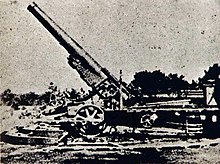Type 96 24 cm howitzer
| Type 96 24 cm howitzer | |
|---|---|
| General Information | |
| Military designation: | 九六 式 二十 四 糎 榴 弾 砲 |
| Manufacturer country: |
|
| Development year: | 1936 |
| Production time: | 1936 to 1945 |
| Number of pieces: | 8th |
| Weapon Category: | Howitzer siege gun |
| Technical specifications | |
| Pipe length: | 5.782 m |
| Caliber : |
240 mm |
| Caliber length : | L / 24 |
| Weight ready for use: | 37,650 kg |
| Elevation range: | 0 to +65 degrees |
| Side straightening area: | 120 ° |
| Furnishing | |
| Closure Type : | Screw lock |
| Ammunition supply: | individually |
The Type 96 24 cm howitzer ( Japanese 九六 式 二十 四 糎 榴 弾 砲 , Kyūroku-shiki nijūyon-senchi ryūdanhō ) was a howitzer that was used by the Imperial Japanese Army during the Pacific War from 1942 to 1945. The designation Type 96 indicates the year of the introduction of the troops, the year Kōki 2596 or 1936 according to the Gregorian calendar.
history
Since the successful siege of Port Arthur , heavy howitzers had assumed a high priority within the Imperial Japanese Army. This resulted in the development of several siege guns that could also be used as fortress and coastal guns at the same time. The Type 45 24 cm howitzer , which was getting on in years at the beginning of the 1930s , had enormous penetrating power, but it took a 50-man crew two days to assemble. The Type 7 30 cm howitzer introduced in 1918 was even heavier (59–97 tons) and had even greater penetrating power. Although the army saw their needs met with these siege guns, two new guns, the Type 96 15 cm Howitzer and the Type 96 24 cm Howitzer, were commissioned in 1936 , both of which were lighter and more mobile than their predecessors . The 24 cm howitzer benefited from the design concepts of the Type 96 15 cm howitzer. It fired a relatively heavy grenade, but it hit with significantly different ranges. It was first used in 1942 during the invasion of the Philippines, and only eight were produced.
Calls
The Type 96 howitzer was first used in 1942 during the invasion of the Philippines , when the US-Philippine forces withdrew to the Bataan Peninsula . The first Japanese attack to crush the enemy failed due to resistance from the Allies . Therefore, the commander in chief of the 14th Army , Lieutenant General Homma Masaharu , sent strong artillery units to deal with the situation. Among the 300 guns called up were two Type 96 howitzers from the 2nd Independent Heavy Artillery Company. On April 3, 1942, the Japanese guns opened fire at 9:00 a.m. and continued until 3:00 p.m. During the six-hour bombardment, the 2nd Independent Heavy Artillery Company fired 80 rounds.
In the course of the invasion of the Philippines on May 4, 1942, the island fortress Corregidor was bombarded , with the Type 96 howitzers again being used and, together with Type 45 24 cm howitzers, firing a total of 2915 rounds. Corregidor fell into Japanese hands on May 6, 1942.
1945 some type-96 howitzers were in Manchuria to the fortress Koto (Ch. Hutou , Hulin moved) to the Japanese defense in case of a Soviet strengthen attack. The Japanese army had eight fortresses built along the border with the Soviet Union, of which the Kotō fortress on the Ussuri River was the strongest. Large-scale fortifications, similar to the Maginot Line , were guarded by the 4th Border Guard Unit. The 1400-strong crew had two batteries of field guns and howitzers, the Type 90 240 mm railway gun and the experimental 41 cm howitzer . When the Soviets attacked the Japanese positions around the fortress Kotō in August 1945 in Operation Auguststurm , the entire fortress crew was destroyed and all guns except the railway gun were lost.
technology
When it was introduced in 1936, the Type 96 howitzer was a modern siege gun by the standards of the time. Their 185–200 kg grenades could have a devastating effect at a distance of 13,500–16,000 meters. However, the Type 96 suffered from uncontrolled different ranges of the projectiles. This problem could never be fixed and only eight copies of the Type 96 were made. For the transport, the howitzer, divided into four load groups, could be moved by tractors. To set up the fire position, a one-piece slewing ring was firmly anchored in the ground. The gun mounted on the turntable had a lateral directional range of 120 ° and could raise the barrel up to 65 °.
Technical specifications
- Caliber: 240 mm
- Caliber length: L / 24
- Pipe length: 5.782 m
- Elevation range: 0 ° to + 65 °
- Side straightening range: 120 °
- Gun weight: 37,650 kg
- Bullet weight: 185–200 kg
- Muzzle velocity V 0 = 530 m / s
- Maximum range: 13,500–16,000 m
- Number of items produced: 8
literature
- Clayton Chun: The Fall of the Philippines 1941-42 (= Osprey Military Campaign Series. 243). Osprey Publishing, Oxford et al. 2012, ISBN 978-1-84908-609-7 .
- Steve J. Zaloga: Defense of Japan, 1945 (= Fortress. 99). Osprey Publishing, Oxford et al. 2010, ISBN 978-1-84603-687-3 .
- Leland Ness: Guide to Japanese Ground Forces 1937-1945: Volume 2: Weapons of the Imperial Japanese Army & Navy Ground Forces Helion & Company, 2014, ISBN 978-19099-8275-8 .
Web links
- Type 96 24cm Howitzer. Taki's homepage, accessed on June 20, 2016 (English).
- Model 45 (1912) 240-mm howitzer. LoneSentry.com, accessed April 14, 2016 .
- The Japanese Artillery Order of Battle Bataan & Corregidor. corregidor.org, accessed April 14, 2016 .
- Japanese Field Artillery. US Military Division of the War Department, accessed April 14, 2016 . PDF
Individual evidence
- ↑ a b c d Ness, p. 151.
- ↑ Type 96 24cm Howitzer. Taki's homepage, accessed on June 20, 2016 (English).
- ↑ a b Ness, p. 149
- ↑ Ness, p. 150
- ↑ a b c The history of battles of Imperial Japanese Artillery Forces. Taki's homepage, accessed March 12, 2015 .
- ^ A b The Japanese Artillery Order of Battle Bataan & Corregidor. corregidor.org, accessed April 14, 2016 .
- ↑ Soviet-Japanese fighting in World War II. Retrieved June 20, 2016 (Japanese).
- ^ Ness, p. 154

